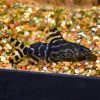No products in the cart.
The Synodontis brichardi Catfish, also known as Brichard’s Synodontis, is a fascinating and elegant freshwater species native to Lake Tanganyika in East Africa. This catfish stands out in aquariums thanks to its elongated body, pale silver to light gray coloration, and the bold, dark vertical stripes that run across its sides. Its graceful flowing fins and long whisker-like barbels give it a unique appearance, making it a highly desirable species for aquarists who appreciate distinctive bottom-dwelling fish.
This catfish grows to about 6 to 8 inches in length, making it a moderately sized Synodontis species that can be comfortably housed in aquariums starting at 55 gallons or larger. It thrives in aquariums that mimic its natural rocky lake environment, with plenty of caves, crevices, and driftwood to provide security and hiding spaces. The Synodontis brichardi is primarily nocturnal, meaning it will be most active during the evening and night hours, although in a calm environment it may emerge during the day as well.
Water parameters are important when keeping this Tanganyikan species. Ideal conditions include a temperature range of 75–82°F (24–28°C), a pH between 7.5 and 9.0, and water that is moderately hard to hard. This reflects the alkaline conditions of Lake Tanganyika. Good filtration, oxygenation, and regular water changes are vital to ensure stability, as this species can be sensitive to poor water quality. A sandy or fine substrate is also recommended, as it will help protect the barbels while the catfish searches for food at the bottom of the aquarium.
The diet of the Synodontis brichardi should be varied and balanced. In the wild, it feeds on small invertebrates, insect larvae, algae, and detritus. In aquariums, it adapts well to prepared foods, including high-quality sinking catfish pellets, algae wafers, and vegetable matter such as cucumber, zucchini, and spinach. Supplementing with frozen or live foods like bloodworms, brine shrimp, and blackworms will not only improve its condition but also enhance its natural coloring. Feeding in the evening is best, as this aligns with its nocturnal behavior.
In terms of temperament, the Synodontis brichardi is generally peaceful, although it may be territorial toward its own kind if the tank is too small or lacks hiding places. It is best kept either singly, in a bonded pair, or in a group with sufficient space to reduce competition. Tank mates should include other Tanganyikan cichlids, larger tetras, rainbowfish, and other robust species that can tolerate similar water conditions. It is an excellent companion for African setups and adds activity and character to the lower levels of the tank.
Frequently Asked Questions
1. How big does the Synodontis brichardi Catfish get?
It usually grows to around 6 to 8 inches when fully mature.
2. Is the Synodontis brichardi aggressive?
No, it is generally peaceful but may display territorial behavior toward other catfish if space is limited.
3. What is the ideal tank size?
A minimum of 55 gallons is recommended, with larger tanks preferred for groups.
4. What should I feed this catfish?
A diet of sinking pellets, algae wafers, vegetables, and supplemental live or frozen foods is best.
5. How long does the Synodontis brichardi live?
With proper care, it can live for 10 to 15 years, making it a long-term aquarium resident.
For aquarists who enjoy unique African fish, the Synodontis brichardi Catfish is a standout choice. Its bold stripes, hardy nature, and compatibility with Tanganyikan setups make it ideal for intermediate to advanced hobbyists. To learn more about Synodontis species and their care, you can explore reliable resources like Seriously Fish, which provides expert information on freshwater fish.
Be the first to review “Synodontis Brichardi Catfish” Cancel reply
Related products
Sale!
Plecostomus












Reviews
There are no reviews yet.